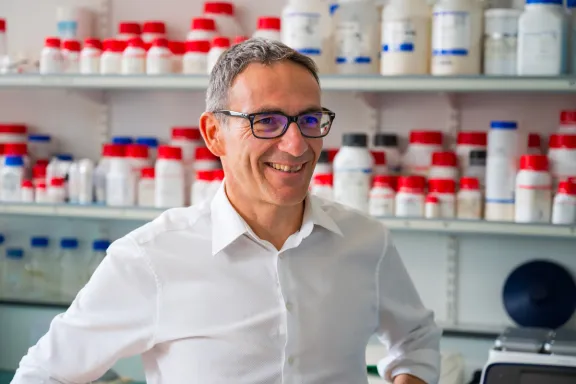Gianni Liti The recipe for the evolution of Saccharomyces yeast
Gianni Liti, CNRS researcher, head of the « Population genomics and complex traits » group, Institute for Research on Cancer and Aging, Nice (IRCAN)
- 2024 • Impulscience

Micro-organisms evolve in complex communities. These communities are connected by a dense network of interactions that underpin all the planet's ecosystems. Gianni Liti intends to produce an overview of these interactions. To do this, he has chosen a very special micro-organism: Saccharomyces cerevisiae. Better known as baker's yeast, it is also a valuable model organism for scientists.
Revealing the genetic architecture of Saccharomyces
Interactions between different species of micro-organisms very probably have an impact on their evolutionary histories. To date, the underlying mechanisms that generate these biological phenomena are not known. What is certain is that Saccharomyces microbial communities vary according to geography and ecology, i.e. the environments in which they live, and their relationship with these environments.
The research carried out by Gianni Liti and his team has contributed to the development of Saccharomyces yeast as a model for biologists, and more specifically for the study of population genomics. The researcher recently set about analyzing 1,011 Saccharomyces cerevisiae genomes, corresponding to a large proportion of the natural genetic variation of this species on Earth. As a result, he now has one of the best understandings of diversity in a eukaryotic model organism. This work is crucial for the study of other eukaryotes, such as humans, animals and plants, all of which are characterized by the presence of a nucleus containing DNA at the heart of their cells.
Deciphering variations within genomes
By undertaking genomic studies, which look at all the genes and chromosomes in an organism, Gianni Liti has revealed the Asian origin of the Saccharomyces yeast. He also highlighted the genetic differences between domesticated and wild species. His work has, among other things, revealed the impact of human activities on the structure of Saccharomyces populations.
Using cutting-edge genetic approaches, he is now seeking to understand how Saccharomyces yeasts interact with the microbial communities that coexist with them in a given environment.
Understanding relationships between micro-organisms at all levels
Gianni Liti and his team plan to provide an overview of microbial interactions of the yeast Saccharomyces. Their idea is to measure the impact of these interactions on genes, their expression and the life cycle of individuals.
Impulscience® will enable them to elucidate the microbial communities of Saccharomyces across hundreds of ecological niches, both wild and domestic. They will then analyze, in the laboratory, the interactions between Saccharomyces cells and other species in microbial communities. They will also assess the impact of these interactions on the transfer of certain genes between species or between yeast cells infected by bacteria. The ultimate aim of this project is therefore to reveal the molecular basis of interactions between species and to deduce the role they have played in the evolution of Saccharomyces species.
Gianni Liti in a few words
Gianni Liti defended his doctoral thesis in 2000 at the University of Perugia in Italy. After spending around ten years in the UK as a post-doctoral fellow, he set up his research team at the Institute for Research on Cancer and Ageing, Nice (IRCAN) in 2012. His team, « Population genomics and complex traits », is pioneering the development of the yeast Saccharomyces cerevisiae as a powerful model for population genomics and quantitative genetics studies.

-
2000 Doctoral thesis, University of Perugia in Italy
-
2012 Sets up a research team at the Institute for Research on Cancer and Ageing, Nice (IRCAN)
-
2024 Impulscience®





